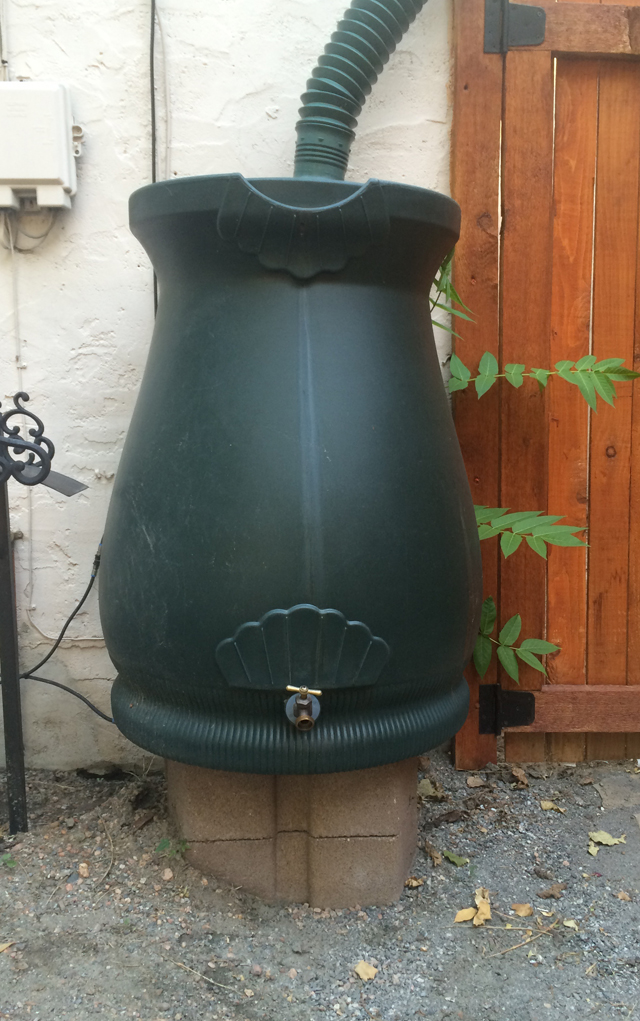
As of last Wednesday, Coloradans can finally legally collect rainwater from their roof. It’s a small victory in the effort to manage water more sustainably in this semi-arid state, and brings with it some interesting impacts.
Opponents had feared collecting roof runoff in rain barrels would reduce the total water available to water rights holders, but studies showing otherwise helped the legislation finally pass. In fact, advocates are predicting that rain barrel use may actually lower overall water consumption by heightening consumer awareness of their water use and prompting more conservationist practices.
“This was something that we saw as a way to engage citizens on water issues,” says Theresa Conley, water advocate for the nonprofit Conservation Colorado, and who was closely involved with the rain barrel legislation. “It’s much more about how we manage our water than it is about actually the physical rain barrel gardening tool.”
Ted Zukoski, a Boulder-based environmental attorney, received his 50-gallon rain barrel as a Father’s Day present from his wife and set it up last week. Zukoski’s family of four typically uses less water than they receive in their water budget — allotted to them on their monthly utility bill and based on their household size — and the rain barrel is helping even more.
“I’ve just been going to the spigot and filling up pitchers and watering plants around the yard,” Zukoski says. “We certainly are thinking about our water consumption, and how we can use the rain barrel to make it so that we don’t have to buy so much.”

According to the new legislation — House Bill 16-1005 — individual households and multifamily units of up to four families are allowed to have up to 110 gallons of rainwater storage capacity, using a combination of no more than two rain barrels to store rainwater for outdoor use. (For comparison, a single family home in Boulder is allotted a 7,000 gallon water budget in the winter, or about 233 gallons of water per day.) Estimates predict only a small percentage of people will opt to install a rain barrel.
A Colorado State University study showed that temporarily holding this relatively small amount of rainwater would have no impact on the total amount of runoff that makes it to the state’s streams, and would not harm the “prior appropriation system” which governs water use in Colorado. In other words, water rights holders, who own the rights to specific quantities of water from specific sources at specific times, would experience no reduction in the water to which they have rights as a result of rainwater harvesting in rain barrels.
“I think the concept of not being able to collect rainwater at people’s homes was confusing to them, and seemed archaic,” Conley says. “It cast a shadow on our prior appropriations system, making it look like it wasn’t responsive and flexible, when in fact it is.”
Deserai Anderson Crow, water researcher and associate professor at the CU Denver School of Public Affairs, says the rain barrel rule sends the message that all Coloradans have the choice to use their water more sustainably, even if they don’t actually choose to use a rain barrel. Perhaps more importantly, it can be a way for citizens to connect with the larger issue of water availability in a state whose population continues to balloon.
“We have the water we need to do what we want, just not all at the same time or place,” she says. “We are going to need to make some serious choices as a state…We are going to likely need a combination of approaches, including water savings measures, water storage and possibly more water development.”
Reagan Waskom, director of the Colorado Water Institute at CSU responsible for the rainwater runoff study that bolstered support for rain barrels, says there’s still plenty of work to be done to protect and sustain the state’s water supply.
“A priority needs to be placed on our rivers and watersheds to sustain their ecological integrity and the services they provide,” he says. “Smart urban growth with a smaller water, energy and transportation footprint is important as well.”
That’s a challenge no amount of rain barrels will solve.
“Colorado needed to get over this rainwater harvesting hurdle,” Waskom says. “It was simply no big deal…but in the big scheme of things it will help us move along the continuum of water conservation and awareness for the general public.”














